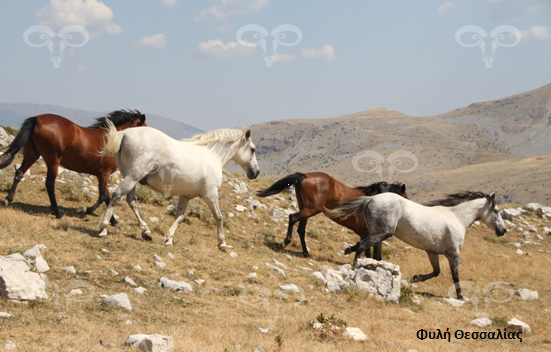History
The Thessaly horse evolved in the lowlands of Thessaly and the surrounding area. The Thessalian plains have been a horse breeding area since ancient times and the Thessaly breed is inextricably linked with ancient myths such as that of the Centaurs. Alexander the Great’s horse, Bucephalus, is considered by some to have been of the Thessaly breed. Bucephalus accompanied Alexander in all his campaigns and when his horse died, Alexander honored it as a companion and comrade in arms.
The Thessaly horse was mainly used for cultivating the soil, for riding and transport. They are strong, abstemious and of great endurance, qualities which make the Thessaly breed special.
During the inter-war period they crossbred with indigenous mountain type breeds, as well as Thoroughbreds. All members of the breed were in the service of the WWII effort because of their exceptional traits; unfortunately, very few returned when the war was over. At present, local breeders, in cooperation with the Agricultural University of Athens and the Ministry of Agriculture, are studying the horses in the region in order to identify the morphological and quality traits of the Thessaly breed.
Morphological Traits
The Thessaly horse is the second largest Greek breed, with a height of 140-150 cm at the withers. The head is large, but not bulky, the neck is relatively thin, the dorsal line is straight, the tail is set low and the mane and tail are long.
The coat colour is usually bay, chestnut or grey. The hooves are always dark, while facial marks are rare.
Use
In the past it was used as a pack animal, in agricultural work, as a draft horse for small carriages as well as horse riding. Today it is mostly bred for horse riding and entertainment. The special talents of the Thessaly horses allow them to become excellent athletic horses in sports such as equine endurance and show jumping.
Population
Even though there are many horses in the Thessaly region and many resemble the Thessaly breed both in appearance and physique, they lack the quality characteristics.
Today the breed is considered practically extinct despite the fact that some traits of the breed can be found among the horse populations of Thessaly and Western Macedonia.
According to data from the Animal Genetic Resources Center (2019), 942 female and 242 male animals are currently registered in the studbook.
An extensive and detailed study is needed in order to identify the breed characteristics and create a breed standard. The later can be used as a tool to overcome the two main problems of immense phenotypic diversity and high levels of inbreeding that are observed in the existing population.
Today, the population size and breed status are “unknown”.




